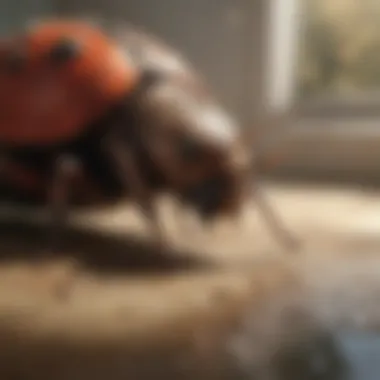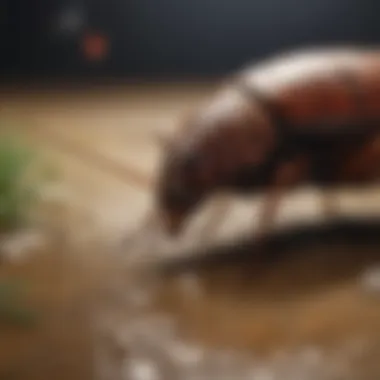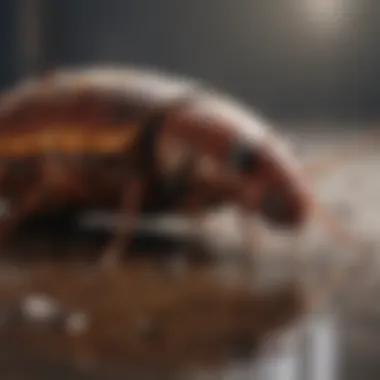Effective Strategies to Eliminate Roaches from Drains


Intro
Roaches in drains can be a significant nuisance for homeowners. They pose not only a sanitary risk but can also affect the overall well-being of living spaces. This issue calls for a thorough understanding of these pests, particularly their biology and habits. Knowing the underlying factors that contribute to roach infestations in drains is essential to formulating effective strategies for eradication. This article will explore the identification, life cycle, prevention strategies, and control methods relevant to tackling this issue.
Understanding the Pest
Identification
Identifying the specific type of roach involved is crucial, as different species may require varied approaches for control. The most common types found in drains are the German cockroach and the American cockroach. The German cockroach is smaller, typically brown with two dark stripes on its back, while the American cockroach is larger, reddish-brown, and can fly. Both species thrive in damp environments, making drains an ideal habitat.
Life Cycle
Roaches reproduce quickly, which complicates elimination efforts. A female German cockroach can produce multiple egg cases during her lifetime, each containing about 30-40 eggs. These eggs hatch into nymphs, which reach maturity in about a few months. Understanding this life cycle can help in implementing timely measures to curb infestations before they escalate.
Pest Prevention Strategies
Environment Modification
One effective tactic is modifying the environment to discourage roaches. This includes keeping drains clean and free of food residues. Regularly flushing drains with hot water can kill nymphs and prevent adults from settling. It is also wise to repair any leaks and close off any access points to minimize dampness.
Physical Barriers
In addition to modifying the environment, physical barriers can also deter roaches. Installing mesh screens over drain openings can block access, while using drain covers when not in use serves the same purpose. These barriers are simple yet effective in preventing infestation.
Control Methods
Chemical Control
When infestations occur, chemical control methods may be necessary. Options include various insecticides specifically designed for roaches. These can be applied in areas where roaches are likely to enter drains. However, it’s essential to follow the manufacturer's instructions carefully for safety.
Biological Control
On the other hand, biological control options can minimize environmental impact. Introducing natural predators, like certain species of wasps, can help. Alternatively, using diatomaceous earth can be effective; it acts as a desiccant and targets roaches without harmful chemicals.
"Addressing roach problems at their source is vital for long-term control."
Understanding Roach Behavior
Understanding the behavior of roaches is pivotal in developing effective strategies for their elimination from drains. Knowledge about their biological traits, habitat preferences, and feeding habits can aid homeowners in effectively targeting their interventions. With this information, one can create a thorough plan to address both immediate issues and long-term management of potential infestations.
Roach Species Commonly Found in Drains
Several species of roaches are commonly found in drains. The German cockroach is prevalent in urban areas due to its ability to thrive in a variety of environments. It prefers warm, humid conditions, which makes drains an ideal habitat. The American cockroach, larger in size, can also be found in plumbing, especially in basements and commercial establishments. Not to be overlooked, the Oriental cockroach favors cooler, damp places, which often include drains. Knowing which species is present can direct the appropriate measures for eradication.
Habitat Preferences
Roaches seek environments that provide food, moisture, and shelter. In drains, particularly, these insects find a perfect combination of factors conducive to their survival. They prefer areas that are dark and humid, which contribute to their sustenance. Furthermore, organic material that accumulates in drains serves as food source. Understanding these preferences equips homeowners to make their environments less inviting to these pests.
Feeding Habits
Roaches are omnivorous scavengers, consuming a wide variety of materials including grease, food crumbs, and even soap residue. Their scavenging nature means they do not require specialized food sources. Instead, anything organic found in drains is fair game. Importantly, they can survive on minimal food content, making it essential to maintain clean drains to reduce their feeding opportunities. This behavior underlies the need for regular cleaning and maintenance as a proactive measure.
"Understanding roach behavior is not just about knowing their presence; it's about understanding their needs and the environment that supports them."
Addressing the behaviors of roaches will not only assist in their elimination but will also contribute to long-term prevention strategies, creating a less hospitable environment for future infestations.
Identifying a Roach Infestation


Recognizing a roach infestation is the first crucial step toward effective control and eradication. If left unchecked, a few roaches can quickly escalate into a much larger problem, impacting both your comfort and health. Accurate identification of these pests allows homeowners to choose appropriate strategies tailored to the severity of the issue. Moreover, understanding the signs and symptoms of an infestation facilitates timely action, thus preventing further developments.
Signs of Infestation
Identifying the presence of roaches can be straightforward if you know what to look for. Some of the most common signs include:
- Droppings: Roach droppings resemble ground coffee or black pepper. They can be found near areas where roaches nest or travel.
- Egg Cases: The egg casing, called an ootheca, is a key identifier. It’s brown and oval-shaped, usually containing multiple eggs. Finding these can signal breeding activity.
- Unpleasant Odors: A strong, musty smell often accompanies large infestations, caused by bacteria in their waste.
- Visible Cockroaches: Sometimes, you may actually see live roaches, especially at night when they are more active. Look in dark areas like under sinks or behind appliances.
Regular inspection of your home can help catch an infestation early. Pay special attention to kitchens and bathrooms, as these areas tend to attract roaches due to moisture and food availability.
Assessing the Severity
Once an infestation is confirmed, it is essential to assess its severity. This step is crucial in determining how to effectively address the issue. Several factors contribute to evaluating the extent of a roach presence:
- Population Size: Begin by counting the number of roaches and egg cases found in your home. A small number may suggest early signs, while large numbers indicate a significant infestation.
- Health Risks: Note any health concerns, particularly if household members are allergic to roaches or if young children may be exposed.
- Location: The frequency of sightings in various locations can help determine the severity. If roaches are seen in multiple rooms, it may imply a widespread issue rather than a localized one.
Utilizing a systematic approach will provide clarity on how urgent the situation is. If the infestation is severe, professional pest control may be required to ensure complete eradication.
Identifying the extent of a roach infestation helps in choosing the right treatment strategy and ensuring a thorough approach to pest control.
In summary, identifying an infestation involves recognizing signs and assessing its severity. Both steps are vital in formulating an effective plan to eliminate roaches from drains, contributing to a healthier living environment.
Roaches and Drain Systems: The Connection
Understanding the relationship between roaches and drain systems is crucial in effectively addressing infestations. Drains serve as a common entry point for these pests, and knowledge of how they operate can significantly influence pest management strategies.
Roaches are resilient creatures that thrive in environments offering moisture, organic matter, and warmth. Drains provide these conditions, creating an ideal habitat. Identifying their entry methods and the reasons they are drawn to these areas helps develop targeted solutions. This understanding lays the groundwork for immediate and preventative measures to eliminate and manage roach populations residing in drains.
How Roaches Enter Drains
Roaches exploit numerous pathways to access drain systems. The most typical route involves spaces between pipes, gaps near sink joints, or cracks in infrastructure. They are agile and can maneuver through tight spaces with relative ease. Common entry points include:
- Gaps in plumbing connections: Loose fittings and poorly installed pipes can create openings.
- Damaged vent pipes: Breaks in vent systems allow roaches to travel from the building's exterior.
- Sewer systems: Roaches can move from one part of the sewer to another, reaching homes through drain lines.
Understanding these channels is essential for blocking potential access points during pest control efforts.
Why Drains are Attractive to Roaches
Roaches are attracted to drains for several reasons that stem from their biological needs:
- Moisture: Drains provide a constant source of moisture, which is vital for roaches to survive and reproduce.
- Food Sources: Organic matter often accumulates in drains, providing nourishment for these insects. Food residues, grease, and even decomposing matter can be a feast for roaches.
- Safety: Drains offer a hidden environment, protecting roaches from predators and human interference.
Given these factors, maintaining a clean and dry drain system becomes essential in deterring roaches. Regular cleaning, sealing openings, and ensuring proper drainage can reduce the likelihood of infestations.
Immediate Solutions for Drain Roaches
The presence of roaches in drains can lead to significant hygiene and health concerns. Immediate solutions to eliminate drain roaches are vital not only for the comfort of living spaces but also for preventing potential infestations from escalating. Addressing the issue promptly helps in minimizing any damage these pests may cause. The following sections provide a detailed approach to effective immediate measures.
Using Boiling Water
One of the simplest yet effective solutions for tackling roaches is pouring boiling water down the drain. Boiling water kills both roaches and their eggs, disrupting their life cycle. It is especially beneficial when used regularly as a preventive measure. To effectively use this method:
- Boil a sufficient amount of water. About two to three liters should suffice for an average sink or drain.
- Carefully pour the boiling water down the drain. Take caution to avoid any spills that could cause burns.
- Repeat weekly in areas where you suspect roach activity. This method is inexpensive and non-toxic, making it suitable for households with children and pets.
Chemical Drain Cleaners
For a more aggressive approach, consider chemical drain cleaners. These products not only eliminate organic materials that attract roaches but also combat existing infestations. It is important to choose systematic and safe chemical options that are effective against roaches. When using chemical drains cleaners, keep these points in mind:
- Read the label clearly. Following manufacturer instructions is crucial for safety and effectiveness.
- Use appropriate safety gear. Gloves and goggles should be worn to prevent contact with chemicals.
- Avoid mixing different cleaners. This can create hazardous reactions.


Using chemical drain cleaners can yield quick results, but they should be used in conjunction with other methods for long-term effectiveness.
Traps and Baits
Deploying traps and baits is another immediate solution to control roach populations. These products can be highly effective when placed strategically near drains and other suspected areas of infestations. Baits lure roaches in with enticing food and deliver poison that kills them. Consider the following when using traps and baits:
- Select the right type of trap or bait. Gel baits and sticky traps are often recommended for drain areas.
- Place traps in hidden areas. Target places under the sink and behind appliances to maximize efficacy.
- Check and replace regularly. Regular maintenance ensures traps remain effective and prevents additional bugs from occupying the space.
Using a combination of these methods creates a layered defense against drain roaches, addressing both immediate and potential future infestations.
Eco-Friendly Alternatives
In addressing the vexing issue of roach infestations in drains, eco-friendly alternatives are increasingly essential. These methods leverage natural components, aiming to eliminate pests without the harsh chemicals that can pose risks to health and the environment. Implementing sustainable practices not only minimizes the ecological footprint but also adds safety for households, especially where children and pets may be present.
Benefits of Eco-Friendly Alternatives:
- Safety: Natural ingredients usually do not emit toxic fumes or leave harmful residues.
- Environmental Sustainability: These solutions often utilize biodegradable materials that do not contribute to pollution.
- Cost-effectiveness: Many natural pest control options are readily available and can be combined with pantry items, reducing overall costs.
More households are recognizing the need for effective yet safe solutions. Awareness of the impact of chemical pest control methods has swayed a significant number of individuals towards eco-friendly options. A crucial point to understand is that some natural methods can be as effective as conventional treatments, especially for manageable infestations. Combining these with preventive measures enhances the long-term management of roaches.
Natural Ingredients for Pest Control
Using natural ingredients can provide an efficient way to combat roaches lurking in drains. Common household items can act effectively against these pests. Here are a few notable options:
- Boric Acid: This is a naturally occurring compound that, when ingested by roaches, acts as a slow poison. When used carefully, it can be sprinkled around the drain or the surrounding areas.
- Diatomaceous Earth: This fine powder is made from fossilized algae and can dehydrate roaches upon contact. An application near entry points can be beneficial.
- Soap and Water Mixture: A mix of dish soap and water can suffocate roaches when sprayed directly on them. It is simple to prepare and has immediate effects.
- Essential Oils: Oils like peppermint and tea tree can deter roaches due to their strong odors. Mixing them with water and spraying around drains often yields promising results.
Considerations When Using Natural Ingredients:
- Ensure proper application, as some methods can lead to unintended consequences if misapplied.
- Effectiveness may vary based on the species of roach and the size of the infestation. Therefore, patience is necessary.
DIY Solutions for Homeowners
Homeowners possess the capacity to implement effective DIY strategies against drain roaches with relative ease. These methods promote not only pest control but also reinforce a sense of empowerment in managing one’s living space.
Some practical DIY solutions include:
- Regular Cleaning: Frequent cleaning of sinks and disposal of food scraps and debris that can attract pests is key.
- Flushing with Vinegar and Baking Soda: This combination can help clear out grime and deter roaches. Pour baking soda followed by vinegar into the drain, allowing it to fizz before rinsing with hot water.
- Citrus Peels: Placing citrus peels in drains harbors a natural repellent property. Roaches tend to avoid the scent of citrus, making it a simple preventative measure.
- Homemade Traps: Using a jar with sugar water can create a trap. The sugar attracts roaches, while they find it difficult to escape the slick sides.
By integrating such DIY methods into a regular routine, homeowners can maintain a cleaner environment that is less hospitable to roaches.
In summary, opting for eco-friendly alternatives and implementing simple DIY solutions empowers households. It leads to sustainable pest management, emphasizing safety for both families and the environment.
Preventative Measures
Preventative measures are essential in controlling and eliminating roaches from drains. Taking proactive steps can significantly minimize the risk of infestations. By focusing on preventative actions, homeowners can create an environment that discourages roaches from finding shelter and sustenance in their drains. Implementing these strategies not only enhances hygiene but can also save time and money in the long run. Simple habits can prevent significant problems related to pest management.
Maintaining Clean Drains
Keeping drains clean is a critical task in preventing roach infestations. Food particles, grease, and organic matter accumulate in drains, creating a perfect habitat for these pests. To maintain clean drains, several practices should be employed:
- Regular Cleaning: Use a mixture of hot water and vinegar weekly to flush out any buildup. This helps in removing potential food sources and eliminates odors that attract roaches.
- Avoid Dumping Food Waste: Dispose of food scraps properly and never wash leftover food down the drain. Instead, use compost bins or waste disposal systems designed for food.
- Use a Drain Strainer: Installing a drain strainer or cover can trap debris before it enters the plumbing system, keeping residue out of sight and minimizing food sources for pests.
Taking these steps can drastically reduce the chances of roaches thriving in drains.
Sealing Entry Points
Sealing potential entry points is another vital aspect of preventing roaches from accessing drains in the first place. Understanding how roaches navigate through homes can guide homeowners in making necessary changes. Key actions include:
- Inspecting Pipes and Fixtures: Look for gaps or holes around pipes, faucets, and fixtures. Sealing these openings with caulk or weather stripping can block roach access.
- Repairing Leaks: Fix any leaks in plumbing systems, as wet environments are particularly inviting for roaches. Wet areas provide moisture, needed for their survival.
- Covering Vents: Ensure that vents leading to drains are screened properly. This stops roaches from crawling up through ventilation pathways.


Properly sealing entry points eliminates easy routes for roaches, making it less likely they will make drains their home.
Regular Inspections and Monitoring
Implementing routine inspections and monitoring is essential for early detection of any potential infestations. Being proactive can lead to immediate solutions if any signs of roaches are noted. Critical components of this process involve:
- Frequent Checks: Set a schedule for examining drains and surrounding areas for any signs of roaches, including droppings or shed skin. Regular vigilance can catch infestations before they escalate.
- Using Monitoring Tools: Consider placing sticky traps near drains to monitor activity. They not only inform about the presence of roaches but also offer insights into peak activity times.
- Recording Observations: Maintain notes on inspections, noting any occurrences of pests or unusual changes. This log can prove invaluable in recognizing patterns or triggers for infestations.
Professional Pest Control Options
When dealing with a serious roach infestation in drains, sometimes professional help is the most effective strategy. It is vital to recognize that while DIY methods can be effective, they may not fully address the underlying issues. Here, we discuss the specific elements, benefits, and considerations of engaging a pest control professional.
When to Call a Professional
Identifying the right moment to bring in a pest control expert can make a significant difference in managing a roach problem. Some common indicators include:
- Persistent Infestations: If roaches keep returning despite your cleaning and preventative efforts, it may indicate a larger issue.
- Health Concerns: Roaches can be carriers of allergens and bacteria. If you notice respiratory issues or increased allergy symptoms in your home, it’s wise to consult a professional.
- Severe Infestations: When the population has grown beyond what you can manage, a professional can assess the situation more comprehensively.
- Structural Damage: If roaches start appearing outside your drains or in other parts of your house, it’s time to take action.
What to Expect from Pest Control Services
If you decide to contact pest control services, understanding their approach is crucial for setting expectations. A professional service typically involves:
- Inspection and Assessment: The initial step involves a thorough inspection of your home, including drains and possible entry points. This helps in understanding the severity of the infestation.
- Customized Treatment Plan: Based on the assessment, experts will develop a tailored plan. This might integrate both chemical and non-chemical methods, emphasizing long-term solutions.
- Application of Treatments: Pest control professionals will use appropriate methods and products to eliminate roaches. This sometimes includes fumigation or targeted treatments along entry points.
- Follow-Up: Post-treatment visits are essential. They monitor the efficacy of the applied methods and make adjustments if needed.
- Education: A competent pest control service often educates homeowners on how to prevent future infestations. They share insights on effective cleaning and maintenance practices.
"Professional pest control not only eliminates the roaches you see but also addresses hidden issues that could lead to more significant infestations in the future."
Long-Term Roach Management Strategies
Long-term roach management is essential for maintaining a pest-free environment, especially in spaces prone to infestations like kitchens and bathrooms. This approach emphasizes more than just immediate solutions. Instead, it looks at sustainable practices that discourage roaches from returning. Developing a robust strategy requires understanding the specific behaviors and preferences of the species affecting your home, along with proactive measures to deter them.
Integrating Pest Control into Routine Maintenance
Incorporating pest control into regular home maintenance is crucial. Consistency in maintenance allows for early detection and management of potential infestations. Here are some strategies to consider:
- Regular Inspections: Schedule monthly inspections of drains and areas around sinks, as these are common entry points for roaches. Look for droppings, egg cases, and any signs of activity.
- Drain Cleaning: Bi-weekly cleaning of drains can help in removing any organic matter that might attract roaches. Use a mix of hot water and vinegar to clear out any buildup.
- Seal Cracks and Gaps: Inspect your home for gaps around pipes and fittings where roaches could enter. Use caulk or foam to seal these openings, preventing entry.
By making pest control a regular part of your home care routine, you reduce the likelihood of significant roach infestations.
Educating Household Members
Awareness among household members is key to effectively managing roaches. Each person plays a part in maintaining a clean environment.
- Understanding Roach Behavior: Teach family members about roach behaviors, including their feeding habits and preferred environments. This knowledge helps everyone recognize potential problems early.
- Cleaning Routines: Encourage everyone to adhere to specific cleaning routines, such as not leaving food exposed and promptly cleaning spills. This avoids creating habitats for roaches.
- Communication: Maintain open lines of communication. If someone notices signs of roaches, they should report it immediately. Early action can prevent larger problems down the line.
"An educated household is the first line of defense against roaches. Sharing knowledge creates an informed environment where everyone is vigilant."
By fostering understanding and responsibility among all household members, you're building a solid foundation for long-term roach management.
The End
In addressing the perennial problem of roaches infiltrating drains, it is essential to grasp the strategies that effectively combat this issue. The methods discussed throughout this article not only provide immediate relief but also pave the way for long-term solutions.
Summarizing Effective Strategies
To summarize, successful eradication of roaches from drains can be achieved through a combination of approaches:
- Immediate Solutions: Utilizing boiling water, chemical drain cleaners, and traps helps in quickly reducing roach populations. These methods act fast, targeting the roaches where they dwell.
- Eco-Friendly Alternatives: Applying natural ingredients like vinegar or baking soda presents a safer option for households. These alternatives are effective and help in maintaining a sustainable living environment.
- Preventative Measures: Regular cleaning of drains, sealing potential entry points, and conducting routine inspections are vital. Keeping drains dry and free of debris makes the environment less hospitable for roaches.
- Professional Pest Control Options: Knowing when to contact professionals can save time and effort. Pest control services provide tailored solutions and ensure a thorough assessment of the problem.
By integrating these strategies, homeowners can effectively keep their living spaces roach-free.
Looking Ahead: Future Research Directions
The fight against drain roaches is ongoing, and as such, future research may take several crucial paths:
- Innovative Treatments: Research into environmentally friendly pest control methods continues to be necessary. Developing new solutions that minimize chemical use can benefit public health.
- Behavioral Studies: Understanding the precise behavior of roaches could lead to advanced strategies used in pest management. Insights gained from behavioral patterns will inform more targeted interventions.
- Integrated Pest Management (IPM): Investigating the effectiveness of IPM practices, which combine cultural, biological, and chemical methods, can be another area of focus. This holistic approach may provide sustainable solutions to pest control in urban environments.







